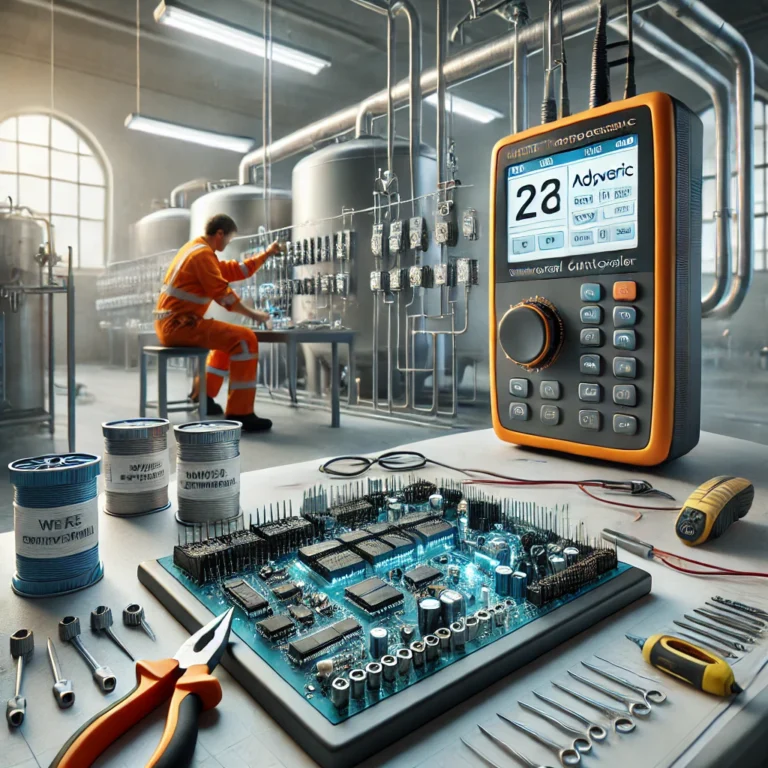How to Configure Hoot Aerobic Universal Controller to Replace Legacy
In today’s fast-paced world of wastewater management, upgrading to modern and efficient systems is crucial. If you’re looking to transition from a legacy controller to the advanced Hoot Aerobic Universal Controller, you’ve made a smart choice. This guide will walk you through how to configure Hoot Aerobic Universal Controller to replace legacy systems, ensuring a seamless upgrade. By following these steps, you can maximize performance and reliability while minimizing downtime.

Understanding the Hoot Aerobic Universal Controller
The Hoot Aerobic Universal Controller is a state-of-the-art device designed to work with a variety of aerobic systems. Its advanced features make it a perfect replacement for outdated legacy systems. Key features include:
- Universal Compatibility: Designed to integrate with multiple system types.
- Enhanced Monitoring: Offers real-time performance tracking.
- User-Friendly Interface: Simplifies configuration and operation.
- Energy Efficiency: Optimizes energy use for cost savings.
- Durability: Built to withstand harsh environments.
Knowing how to configure Hoot Aerobic Universal Controller to replace legacy systems is essential for unlocking these benefits.
Why Upgrade from a Legacy System?
Legacy controllers often lack the features and reliability of modern devices. Upgrading allows you to:
- Improve system efficiency.
- Reduce maintenance costs.
- Access advanced monitoring and alerts.
- Ensure compliance with modern environmental standards.
The process of how to configure Hoot Aerobic Universal Controller to replace legacy systems might seem daunting, but it’s straightforward with the right guidance.
Step-by-Step Guide to Configure Hoot Aerobic Universal Controller to Replace Legacy Systems
1. Preparation
Before starting, gather all necessary tools and information:
- User manuals for both the legacy system and the Hoot controller.
- Tools such as screwdrivers, wire cutters, and multimeters.
- Labeling materials for wires.
Safety first! Always power down the legacy system before proceeding.
2. Remove the Legacy Controller
- Disconnect the power supply.
- Label all wires connected to the legacy controller.
- Carefully remove the controller, ensuring no damage to the wiring or system components.
3. Install the Hoot Aerobic Universal Controller
- Mount the Controller: Position the Hoot controller in an accessible and secure location.
- Wire Connections: Match the labeled wires to the corresponding terminals on the new controller.
- Check Compatibility: Ensure all connections are secure and aligned with the system’s requirements.
4. Configure the Controller Settings
Understanding how to configure Hoot Aerobic Universal Controller to replace legacy systems requires attention to detail:
- Access the configuration menu using the provided interface.
- Set operational parameters such as:
- Aeration cycles.
- Dosing times.
- Alarm thresholds.
- Test each setting to ensure compatibility with your system.
5. System Testing and Calibration
- Power up the system and run a full operational cycle.
- Monitor the system’s performance using the controller’s real-time tracking features.
- Calibrate sensors and alarms to ensure accurate readings and notifications.
6. Final Adjustments and Documentation
- Make any necessary fine-tuning to optimize performance.
- Record all configurations for future reference.
- Train maintenance personnel on how to use the new controller.
Advanced Features of the Hoot Aerobic Universal Controller
Once you understand how to configure Hoot Aerobic Universal Controller to replace legacy systems, you can explore its advanced features. These include:
- Remote Monitoring: The controller supports remote access, allowing you to monitor and adjust system performance from anywhere.
- Data Logging: The built-in data logger tracks performance metrics, helping with troubleshooting and optimization.
- Custom Alerts: Set up customized alerts to notify you of potential issues before they become major problems.
- Energy Usage Insights: Analyze energy consumption patterns to identify areas for cost savings.
- Automatic Updates: Stay current with the latest features and improvements through automatic firmware updates.
Troubleshooting Common Issues
If you encounter problems while learning how to configure Hoot Aerobic Universal Controller to replace legacy systems, consider these tips:
- No Power: Check the power supply and connections.
- Faulty Wiring: Ensure all wires are correctly labeled and connected.
- Inconsistent Operation: Recalibrate sensors and verify settings.
For advanced troubleshooting, consult the Hoot Aerobic Universal Controller’s manual or contact customer support.
Maintenance Tips for Long-Term Reliability
To ensure your Hoot Aerobic Universal Controller continues to operate efficiently:
- Regular Inspections: Periodically inspect wiring and connections for wear or damage.
- Software Updates: Keep the controller’s firmware up to date.
- Sensor Calibration: Calibrate sensors every few months to maintain accuracy.
- Clean the Unit: Remove dust and debris to prevent overheating or other issues.
- Review Logs: Analyze system logs to identify trends or potential problems early.
Benefits of the Upgrade
After successfully learning how to configure Hoot Aerobic Universal Controller to replace legacy systems, you’ll enjoy:
- Increased operational efficiency.
- Reduced maintenance and downtime.
- Enhanced control and monitoring.
- Compliance with modern standards.
- Long-term cost savings due to improved energy efficiency.
Conclusion
Upgrading to the Hoot Aerobic Universal Controller is a smart investment for anyone managing an aerobic treatment system. By understanding how to configure Hoot Aerobic Universal Controller to replace legacy systems, you ensure a smooth transition and improved system performance. Follow this guide closely, and you’ll be well on your way to reaping the benefits of modern technology.
Whether you’re a seasoned technician or new to system upgrades, this step-by-step approach simplifies the process. With proper preparation and execution, your new controller will provide years of reliable service. Don’t wait—upgrade today and experience the future of wastewater management!
Frequently Asked Questions (FAQ): Configuring the Hoot Aerobic Universal Controller
1. Why should I upgrade from my legacy controller?
Legacy controllers often lack modern features like remote monitoring, real-time alerts, and energy efficiency. The Hoot Aerobic Universal Controller offers these advancements and more, helping you save time, reduce maintenance costs, and ensure compliance with current environmental standards. By upgrading, you can improve the reliability and longevity of your aerobic treatment system.
2. Is the Hoot Aerobic Universal Controller compatible with all types of aerobic systems?
Yes, the controller is designed for universal compatibility with most aerobic treatment systems. However, it\u2019s a good idea to check your system\u2019s specifications and compare them with the controller\u2019s manual. In rare cases where modifications are needed, Hoot support can guide you through the process.
3. How difficult is the installation process for someone with no prior experience?
The installation process is straightforward, thanks to the controller\u2019s user-friendly design and detailed manual. However, basic familiarity with wiring and system operations is helpful. For beginners, seeking professional help or consulting with someone experienced can ensure proper installation and configuration.
4. What tools and equipment do I need to install the controller?
You\u2019ll need:\n- A set of screwdrivers (flathead and Phillips)\n- Wire cutters and strippers\n- A multimeter for testing connections\n- Electrical tape or wire connectors\n- Labels for marking wires\n- A flashlight for better visibility during installation\n\nRefer to the manual for any system-specific requirements.
5. How do I prepare my system before installation?
Preparation involves:\n- Powering down the legacy controller and aerobic system to avoid electrical hazards.\n- Carefully labeling all wires connected to the legacy controller.\n- Reviewing both the legacy system\u2019s and the Hoot controller\u2019s manuals.\n- Checking for any signs of damage to wires or components that may need replacement.\n- Organizing your tools and workspace for efficient installation.
6. What are the steps to remove the legacy controller?
Removing the legacy controller requires:\n1. Disconnecting the power supply.\n2. Labeling each wire for easy identification during reconnection.\n3. Unscrewing or unmounting the legacy controller from its position.\n4. Inspecting wires and terminals for wear or damage.\n5. Cleaning the area where the new controller will be installed.
7. What should I do if the Hoot Aerobic Universal Controller doesn’t power on after installation?
Start by:\n1. Checking the power source and ensuring it\u2019s active.\n2. Verifying that all wires are securely connected to the correct terminals.\n3. Testing the power connections using a multimeter.\n4. Consulting the troubleshooting section of the manual for additional guidance.\n\nIf these steps don\u2019t resolve the issue, contact Hoot\u2019s technical support team.
8. Can the controller\u2019s settings be customized for my specific system?
Yes, the Hoot Aerobic Universal Controller allows full customization of settings, including:\n- Aeration cycles\n- Dosing times\n- Alarm thresholds\n- Sensor calibration parameters\n\nThese settings can be adjusted through the user-friendly interface to match the unique requirements of your system.
9. How do I calibrate the sensors for optimal performance?
Calibration is an important step to ensure accurate readings. Here\u2019s how to do it:\n1. Access the calibration menu on the controller.\n2. Use the system\u2019s manual or reference values to input baseline measurements.\n3. Test the sensors by simulating conditions (e.g., aeration or dosing cycles).\n4. Repeat calibration if readings are inconsistent.
10. How does the controller handle alarms and notifications?
The Hoot Aerobic Universal Controller is equipped with advanced alarm features:\n- You can set thresholds for various parameters, such as oxygen levels, pump cycles, and tank conditions.\n- The controller sends audible and visual alerts when these thresholds are breached.\n- Remote monitoring allows you to receive alerts via email or SMS if your system is connected to a network.
11. Is remote monitoring included with the controller?
Yes, the Hoot Aerobic Universal Controller supports remote monitoring. This feature allows you to:\n- Track system performance in real-time.\n- Receive notifications about issues, even when you\u2019re offsite.\n- Access historical data to analyze trends and optimize system performance.\n\nYou may need to set up a compatible network connection or app to enable this feature.
12. What are the common issues faced during installation and configuration?
Some common challenges include:\n- Incorrect Wiring: Ensure wires are labeled and connected correctly.\n- Sensor Calibration Errors: Recalibrate if readings are inconsistent.\n- Power Supply Problems: Check fuses and voltage levels.\n- Outdated Firmware: Update the controller\u2019s firmware before configuration.\n\nAlways consult the troubleshooting section of the manual for detailed solutions.
13. How often should I maintain the controller to keep it running efficiently?
Regular maintenance is key to longevity. Here\u2019s a suggested schedule:\n- Monthly: Inspect wiring, clean the controller, and check for error messages.\n- Quarterly: Calibrate sensors, test alarms, and review operational logs.\n- Annually: Update firmware, perform a full system diagnostic, and replace any worn components.
14. What data can I analyze with the controller’s tracking features?
The controller provides insights into:\n- Aeration cycle durations\n- Pump activity and dosing times\n- Sensor performance (e.g., oxygen levels)\n- Alarm history\n- Energy consumption trends\n\nThese analytics help you optimize system performance and identify potential issues early.
15. How do I know if the configuration is successful?
A successful configuration ensures:\n- All alarms and sensors are functioning as expected.\n- Operational cycles run smoothly without interruptions.\n- Performance data aligns with your system\u2019s specifications.\n- You can monitor and control the system using the controller interface or remote access.
16. What should I do if I encounter errors after installation?
If errors occur, try these steps:\n1. Review system logs to identify the source of the error.\n2. Recheck wiring and connections for accuracy.\n3. Test sensors and recalibrate if needed.\n4. Contact Hoot technical support for advanced troubleshooting.
17. Can I upgrade the firmware on the Hoot Aerobic Universal Controller?
Yes, firmware updates are available to improve functionality and add new features. Check the Hoot website or contact support for the latest updates and installation instructions.
18. Does the controller offer energy-saving features?
The Hoot Aerobic Universal Controller optimizes energy use by:\n- Adjusting aeration cycles based on real-time data.\n- Allowing for customized dosing schedules.\n- Tracking energy consumption to identify inefficiencies.\n\nThese features help reduce operating costs over time.
19. What is the expected lifespan of the Hoot Aerobic Universal Controller?
With proper installation and regular maintenance, the controller can last 10+ years. Its durable design and robust features ensure reliable performance even in harsh conditions.
20. Where can I get additional support for installation or troubleshooting?
Hoot provides comprehensive support resources, including:\n- A detailed user manual\n- Online FAQs and guides\n- Customer support via phone or email\n\nReach out to their team for personalized assistance if needed.

